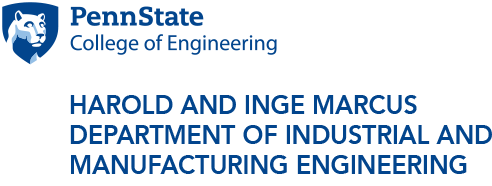The Liberty Bell at Penn State
Ever wonder why there’s an exact replica of the Liberty Bell in the lobby of the Leonhard Building?
The West Philadelphia Bronze Company cast a full-size replica of the Liberty Bell (without the infamous crack) for Foseco, Inc., a supplier of consumable products to the foundry industry, to commemorate the 100th anniversary of the American Foundry Society in 1996.
Foseco, which is now the Foundry Technologies Division of Vesuvius Group, donated the cast to the Harold and Inge Marcus Department of Industrial and Manufacturing Engineering at Penn State to be displayed in the lobby of the Leonhard Building, which was then under construction and officially opened its doors in fall 1999.
The casting of the Foseco Liberty Bell resides outside the Factory for Advanced Manufacturing Education within the department as a symbol of the importance of metal casting in manufacturing processes.
Metal Casters in U.S. History
Six metal casters were signers of the Declaration of Independence thus solidifying the importance of the industry in the birth of U.S. democracy. The metal casting industry was severely affected by acts passed by the British Parliament that restricted commerce in the colonies. Chief among the prohibitive acts was the Iron Act of 1750, which allowed the production of charcoal, pig iron, and other raw materials in the colonies but prohibited the manufacture of finished castings. This meant that foundries could only produce ingots for shipment back to England where they were re-melted and shipped back to the colonies as expensive castings.
The six metal casters who signed the Declaration of Independence were: Charles Carroll of Carrollton Furnace in Carrollton, Maryland; Stephen Hopkins of Hope Furnace in the North Branch of the Pawtuxet River in Rhode Island; George Ross of Mary Ann Furnace in West Manheim Township, Pennsylvania; James Smith of Codorus Creek Forge in York County, Pennsylvania; George Taylor of Durham Furnace in Bucks County, Pennsylvania; and James Wilson of Hopewell Furnace in Union Township, Pennsylvania.
For the history of how the original Liberty Bell was cast go to the Liberty Bell Center website.
Metal Casting in the United States
With more than 3,000 foundries that employ more than 200,000 people nationwide, the metal casting industry remains a vital part of the U.S. economy. Metal casters create 13 million tons of intricately shaped castings each year for a wide variety of applications by using what is primarily considered scrap metal.
Metal castings are used in more than 90 percent of all durable goods, which means that most U.S. households contain more than a ton of cast metal components.
The Pennsylvania foundry industry includes more than 150 foundries that employ around 20,000 Pennsylvanians.
For more information about metal casting at Penn State, contact Robert Voigt, professor of industrial engineering and faculty adviser of the Penn State student chapter of the AFS.




